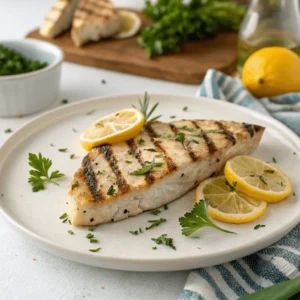Why You’ll Love This Swordfish Recipe
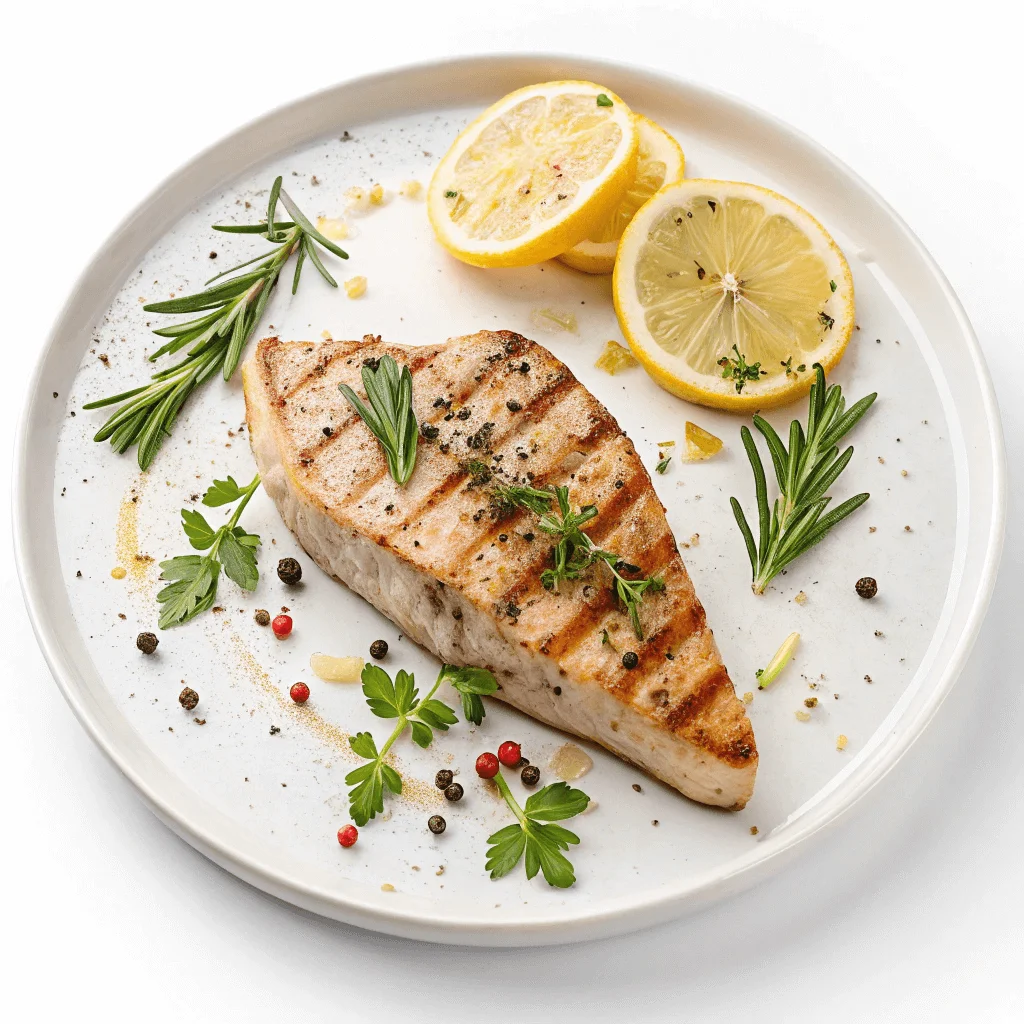
The Health Benefits of Swordfish (Rich in Protein and Omega-3s)
Swordfish is not only a delicious seafood option but also packed with essential nutrients that support overall health. Here’s why adding swordfish to your diet can be a great choice:
- High in Protein – Swordfish is an excellent source of lean protein, with about 20 grams of protein per 3-ounce serving. This helps build and repair muscles, making it an ideal choice for those following a high-protein diet.
- Rich in Omega-3 Fatty Acids – These healthy fats contribute to heart health, reduce inflammation, and support brain function. Omega-3s can help lower blood pressure and improve cholesterol levels.
- Loaded with Essential Vitamins and Minerals – Swordfish is rich in vitamin D, which supports bone health and immune function, and selenium, a powerful antioxidant that protects against cell damage. It also contains B vitamins that help with energy production and metabolism.
- Low in Carbohydrates – Swordfish is naturally low in carbs, making it a great option for low-carb, keto, or Paleo diets.
How Lemon and Herbs Enhance the Flavor of Swordfish
Swordfish has a mild, slightly sweet flavor with a meaty texture, making it a great canvas for various seasonings. Lemon and herbs are the perfect pairing to bring out its natural taste while keeping it light and refreshing:
- Lemon’s Bright and Tangy Touch – The acidity in fresh lemon juice and zest balances the richness of swordfish, cutting through any oiliness and adding a fresh, citrusy brightness.
- Aromatic Fresh Herbs for Depth of Flavor – Herbs like rosemary, thyme, and parsley add an earthy, slightly peppery aroma that complements the fish without overpowering it.
- Garlic and Olive Oil for a Mediterranean Twist – The combination of minced garlic and high-quality olive oil adds richness and enhances the savory notes of the swordfish while keeping it moist during cooking.
- Balancing Seasonings – A touch of sea salt, black pepper, and red pepper flakes rounds out the dish, adding subtle heat and enhancing the overall flavor profile.
A Quick and Easy Seafood Dinner for Any Occasion
One of the best things about this swordfish recipe is how simple yet impressive it is. Whether you’re cooking a casual weeknight dinner or a special meal for guests, this dish is quick to prepare and packed with flavor:
- Fast Cooking Time – Swordfish cooks quickly, taking only about 4-5 minutes per side on the grill or stovetop, making it a great option for busy nights.
- Minimal Ingredients, Maximum Flavor – With just a handful of fresh ingredients, you can create a gourmet-style seafood dish with minimal effort.
- Versatile Cooking Methods – You can grill, pan-sear, or bake swordfish, depending on your preference and available equipment.
- Pairs Well with Many Side Dishes – Serve your lemon-herb swordfish with a light salad, roasted vegetables, quinoa, or garlic butter rice for a balanced and satisfying meal.
This dish is proof that healthy eating doesn’t have to be complicated—just fresh ingredients, simple preparation, and a delicious outcome!
Ingredients You’ll Need for This Recipe
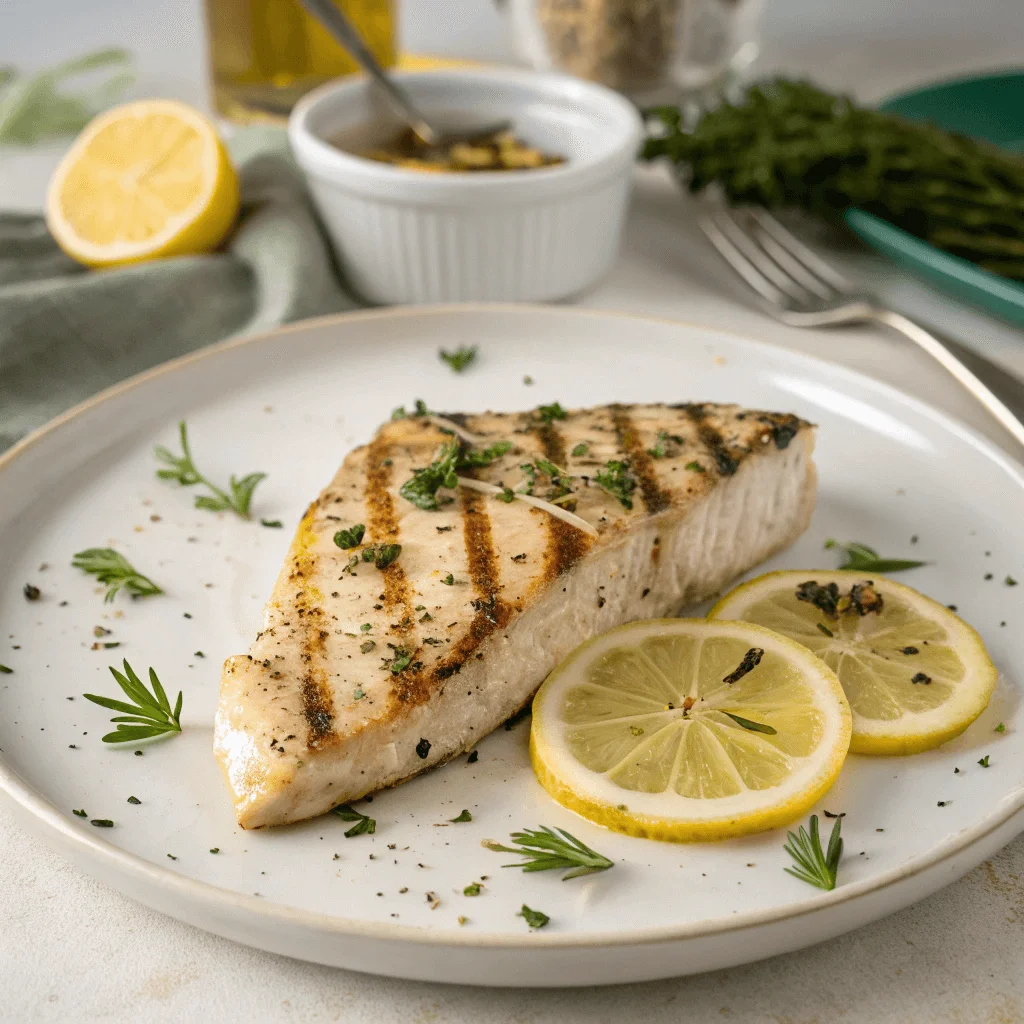
Main Ingredients for Swordfish Recipe with Lemon and Herbs
Each ingredient in this recipe plays a crucial role in enhancing the flavor, texture, and overall quality of the dish. Let’s take a closer look at why these ingredients are essential and how they contribute to a perfectly cooked swordfish steak.
Fresh Swordfish Steak, Olive Oil, Garlic Cloves, Lemon Zest
These core ingredients lay the foundation for a delicious and well-balanced swordfish dish.
- Fresh Swordfish Steak – The star of the dish!
- Choose firm, thick-cut steaks (about 1–1.5 inches thick) with a moist appearance and a mild ocean-like smell.
- Fresh swordfish should have a pale pink or ivory color, free of any brown spots or discoloration.
- If fresh swordfish is unavailable, you can use high-quality frozen swordfish fillets—just be sure to thaw them properly in the refrigerator before cooking.
- Olive Oil – Enhances flavor and keeps the swordfish moist.
- A high-quality extra virgin olive oil (EVOO) adds a smooth richness to the fish.
- It also prevents the swordfish from sticking to the grill or pan while cooking.
- Olive oil contains healthy monounsaturated fats, making this dish even more nutritious.
- Garlic Cloves – Provides a rich, savory depth of flavor.
- Fresh minced or crushed garlic infuses the swordfish with a subtle yet aromatic flavor.
- Roasting or sautéing garlic before adding it to the dish can enhance its natural sweetness.
- Lemon Zest – Adds brightness and a refreshing citrus kick.
- Using both lemon juice and zest enhances the natural flavors of the fish.
- The zest contains essential oils that provide a more intense citrus aroma.
- Helps balance the richness of the fish and olive oil while keeping the dish light and fresh.
Fresh Herbs: Rosemary, Thyme, Parsley
Herbs play an essential role in elevating the dish’s aroma and flavor. Using fresh herbs instead of dried ones gives a more vibrant and fragrant result.
- Rosemary – Earthy and slightly piney in flavor, rosemary pairs well with swordfish’s meaty texture.
- Helps create a more robust, aromatic seasoning.
- Works exceptionally well when grilled or roasted.
- Thyme – Delicate, peppery, and slightly floral, thyme complements the citrusy brightness of the dish.
- Provides a balanced herbal touch without overpowering the fish.
- Works well in both marinades and finishing garnishes.
- Parsley – A fresh, slightly peppery herb that brings out the lightness of the dish.
- Adds color and a fresh bite when sprinkled over the cooked fish.
- Works well as a garnish for a beautiful presentation.
Seasonings: Sea Salt, Black Pepper, Optional Red Pepper Flakes
The right seasonings enhance the swordfish’s natural taste without overpowering it.
- Sea Salt – Essential for bringing out the natural flavors of the fish.
- A pinch of coarse sea salt helps intensify the taste while preventing it from drying out.
- Avoid over-salting, as swordfish has a naturally mild oceanic flavor.
- Black Pepper – Adds a mild kick and depth to the seasoning.
- Freshly ground black pepper gives a subtle heat without overpowering the delicate flavors.
- Helps balance the acidity of the lemon and the richness of the olive oil.
- Red Pepper Flakes (Optional) – A hint of heat for those who love a spicy kick.
- Adds a slight warmth to the dish, complementing the citrus and herbaceous flavors.
- Can be adjusted based on personal preference.
Additional Flavor Enhancers: White Wine, Butter (Optional)
These ingredients elevate the dish by adding richness and complexity.
- White Wine – A splash of dry white wine enhances the dish’s flavor.
- Works well in the marinade or as a cooking liquid for added depth.
- Dry wines like Sauvignon Blanc, Pinot Grigio, or Chardonnay pair well with swordfish.
- Helps to tenderize the fish while cooking and enhances the citrusy flavors.
- Butter (Optional) – Adds a touch of richness and silkiness to the dish.
- Melting a little butter over the fish before serving creates a more indulgent texture.
- Can be combined with garlic and herbs for a restaurant-quality finish.
- If you prefer a healthier option, you can omit butter or replace it with more olive oil.
Final Thoughts
This combination of ingredients ensures that your Swordfish Recipe with Lemon and Herbs is flavorful, aromatic, and perfectly balanced. The freshness of the herbs, the brightness of the lemon, and the richness of the olive oil and garlic come together beautifully to enhance the natural taste of the swordfish.
Step-by-Step Guide to Cooking Swordfish with Lemon and Herbs
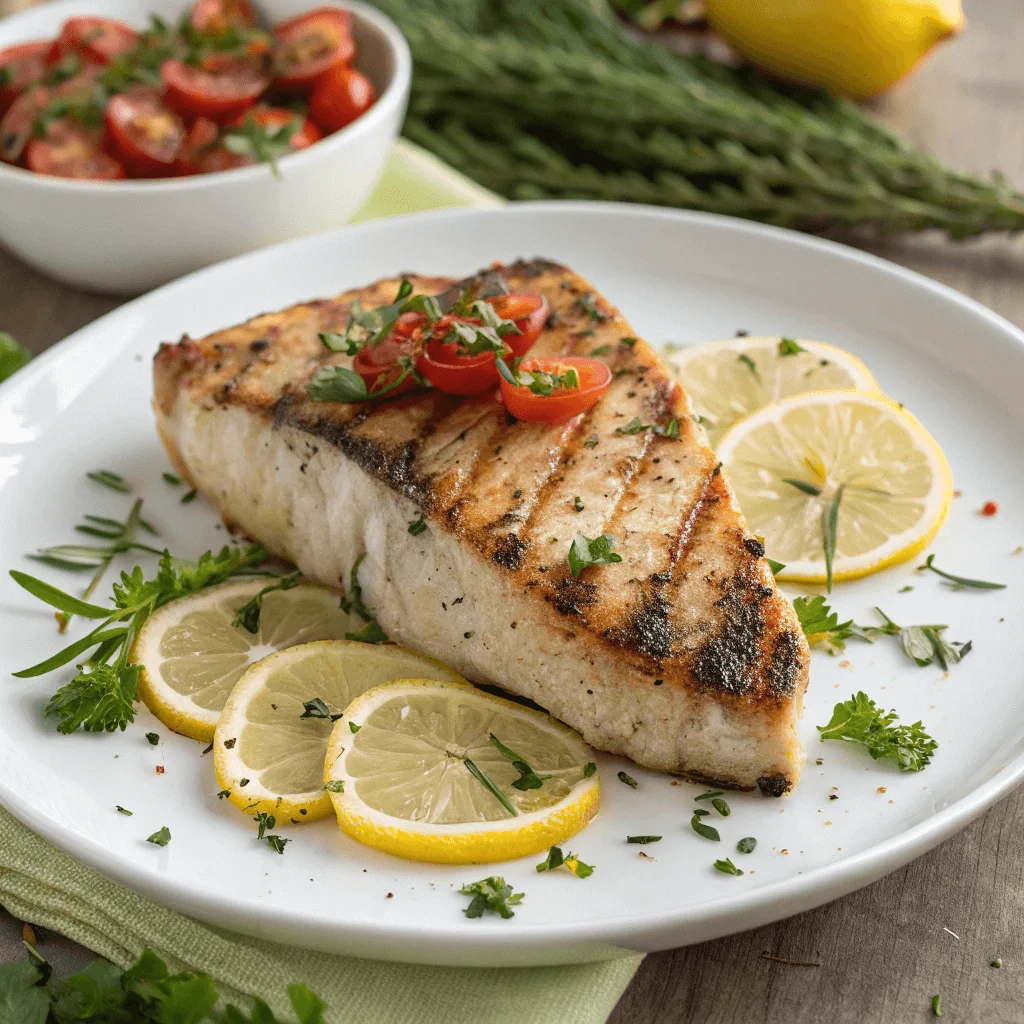
Preparing the Swordfish Fillet: How to Choose and Prep the Best Cut
Properly selecting and preparing swordfish fillets is crucial for achieving the best texture and flavor. Since swordfish has a firm, meaty texture, choosing the right cut and prepping it correctly ensures juiciness, tenderness, and even cooking.
How to Choose the Best Swordfish Fillet
- Look for Fresh, Firm Fillets – A high-quality swordfish steak should have a smooth, moist appearance and feel firm to the touch. It should never feel mushy or overly soft.
- Check the Color – Fresh swordfish is typically pale pink, ivory, or light beige, with a slight translucent quality. Avoid fillets with a dull, brownish, or grayish tint.
- Inspect for a Clean Smell – A fresh cut of swordfish should have a mild ocean scent. If it smells overly fishy or ammonia-like, it’s likely not fresh.
- Look for Even Thickness – Choose fillets or steaks that are about 1 to 1.5 inches thick for even cooking. Thinner cuts can dry out too quickly, while thicker cuts may require longer cooking times.
How to Prep Swordfish Before Cooking
- Pat Dry – Use a paper towel to gently pat the fillet dry. This helps remove excess moisture and ensures a better sear or grill marks.
- Trim the Bloodline (Optional) – The dark bloodline running through the fillet is edible but can have a strong, fishy taste. Trimming it off gives a cleaner flavor.
- Score the Surface (Optional for Grilling) – If grilling, lightly score the surface with a knife. This helps the marinade absorb better and prevents the fillet from curling during cooking.
- Marinate for Maximum Flavor – Let the fish sit in the lemon-herb marinade for at least 15–30 minutes to infuse flavor without over-marinating.
Making the Lemon-Herb Marinade: Combining Olive Oil, Garlic, Lemon Zest, and Herbs
A well-balanced marinade enhances the natural taste of swordfish without overpowering it. The combination of olive oil, garlic, lemon zest, and fresh herbs adds depth and brightness to the dish.
Ingredients for the Lemon-Herb Marinade
- 1/4 cup extra virgin olive oil – Adds richness and keeps the fish moist.
- 3 cloves garlic, minced – Provides a bold, aromatic depth.
- Zest of 1 lemon + 2 tbsp lemon juice – Brightens the flavors and helps tenderize the fish.
- 1 tbsp fresh rosemary, chopped – Earthy and slightly piney, perfect for swordfish.
- 1 tbsp fresh thyme, chopped – Offers a mild peppery taste.
- 1 tbsp fresh parsley, chopped – Adds freshness and a hint of color.
- 1/2 tsp sea salt – Enhances all the natural flavors.
- 1/2 tsp freshly ground black pepper – Adds subtle heat and complexity.
- 1/4 tsp red pepper flakes (optional) – A touch of spice for those who enjoy a bit of heat.
How to Make the Marinade
- Combine all ingredients in a bowl and whisk well to blend.
- Coat the swordfish generously with the marinade, making sure both sides are covered.
- Let it marinate for at least 15–30 minutes but no longer than 1 hour, as too much acid (lemon juice) can start to break down the fish and alter its texture.
- Remove the fillet from the marinade and let any excess drip off before cooking.
Cooking Methods: Grilled, Pan-Seared, or Baked Swordfish
Swordfish is versatile and can be cooked in various ways, each bringing out different flavors and textures. Whether you prefer the smoky char of the grill, the crispy crust of a pan-seared fillet, or the gentle, even heat of baking, here’s how to do it right.
1. Grilled Swordfish (Best for a Smoky, Charred Flavor)
Grilling swordfish adds beautiful grill marks and a subtle smokiness that enhances the dish.
✅ How to Grill Swordfish:
- Preheat the grill to medium-high heat (375–400°F / 190–200°C).
- Lightly oil the grill grates to prevent sticking.
- Place the marinated swordfish steak on the grill and cook for 4–5 minutes per side, flipping only once.
- The fillet is ready when it has golden-brown grill marks and flakes easily with a fork.
- Remove from the grill, squeeze fresh lemon juice on top, and serve hot.
🔥 Pro Tip: If using a gas grill, close the lid for more even cooking. If using charcoal, ensure the coals are evenly spread for consistent heat.
2. Pan-Seared Swordfish (Best for a Crisp, Golden Crust)
Pan-searing is an excellent option for getting a crispy, golden-brown crust while keeping the inside tender.
✅ How to Pan-Sear Swordfish:
- Heat 1 tbsp olive oil or butter in a cast-iron skillet or non-stick pan over medium-high heat.
- Once the oil is hot, place the swordfish fillet in the pan.
- Sear for 3–4 minutes per side until a golden-brown crust forms and the fish is opaque.
- Lower the heat, add a small pat of butter (optional), and baste the fish with it for extra richness.
- Remove from the pan and let it rest for 2 minutes before serving.
🔥 Pro Tip: Avoid overcrowding the pan—cook in batches if needed to maintain high heat for the perfect sear.
3. Baked Swordfish (Best for a Moist, Evenly Cooked Fillet)
Baking is a foolproof method that ensures the fish remains moist and flavorful without the need for constant attention.
✅ How to Bake Swordfish:
- Preheat the oven to 400°F (200°C).
- Place the swordfish steak in a lightly greased baking dish.
- Drizzle with extra marinade or a splash of white wine for added moisture.
- Bake uncovered for 12–15 minutes, depending on thickness.
- The fish is done when it flakes easily with a fork and reaches an internal temperature of 130–135°F (55–57°C) (it will continue to cook slightly after removing from the oven).
🔥 Pro Tip: Add sliced lemons on top while baking for extra citrusy goodness and a beautiful presentation.
Final Thoughts
Each cooking method offers a unique take on swordfish, so choose based on your preference and available cooking tools. Whether you grill for a smoky char, pan-sear for a crisp crust, or bake for a tender finish, the combination of lemon and herbs ensures a light, fresh, and flavorful meal.
Tips for the Perfect Swordfish Steak

How to Prevent Swordfish from Drying Out While Cooking
Swordfish is a lean, meaty fish, which means it can easily become dry or overcooked if not handled properly. Since it lacks the natural fat content of fish like salmon, it requires careful cooking techniques to maintain its juiciness and flavor. Here are some key tips to prevent dryness and keep your swordfish perfectly moist and tender:
1. Don’t Overcook the Fish
- Swordfish is best when cooked to an internal temperature of 130–135°F (55–57°C).
- It will continue to cook from residual heat after being removed from the grill, pan, or oven.
- Overcooking beyond 140°F (60°C) will cause the fish to dry out and become tough.
🔥 Pro Tip: Use a meat thermometer to check the internal temperature and remove the swordfish just before it reaches 135°F.
2. Marinate or Brush with Oil Before Cooking
- A marinade helps to infuse moisture and prevent the fish from drying out.
- If you’re not marinating, brush the fish with a thin layer of olive oil or melted butter before cooking.
- Acidic ingredients like lemon juice or white wine tenderize the fish, but don’t let it marinate for too long (no more than an hour) to avoid breaking down the texture.
3. Cook Over Medium-High Heat for a Short Time
- High heat locks in moisture by searing the outside while keeping the inside juicy.
- Cooking times vary depending on the method:
- Grill – 4–5 minutes per side
- Pan-Sear – 3–4 minutes per side
- Bake – 12–15 minutes at 400°F (200°C)
🔥 Pro Tip: Avoid flipping the fish too often—one flip is usually enough for a good sear while keeping the inside moist.
4. Let the Swordfish Rest After Cooking
- Resting for 2–3 minutes allows the juices to redistribute throughout the fillet.
- Cutting into the fish immediately after cooking can cause the juices to escape, leading to dryness.
The Best Cookware: Cast Iron Skillet vs. Grill vs. Oven
Choosing the right cookware can make a significant difference in how your swordfish turns out. Here’s a comparison of the best cooking methods and their unique benefits:
1. Cast Iron Skillet (Best for a Crispy, Golden Crust)
Why Use It?
- Retains and distributes high heat evenly, creating a perfect sear.
- Locks in juices while forming a delicious crust on the outside.
- Great for adding butter basting for extra richness.
✅ Best For:
- Pan-searing
- Cooking indoors
- Quick weeknight meals
🔥 Pro Tip: Preheat the skillet for a few minutes before adding the swordfish to get a restaurant-quality sear.
2. Grill (Best for a Smoky, Charred Flavor)
Why Use It?
- Gives the fish a delicious smoky, charred taste.
- Keeps the fish light and healthy without excess oil.
- Adds a nice texture with grill marks.
✅ Best For:
- Outdoor cooking
- Summer BBQs
- Pairing with grilled veggies
🔥 Pro Tip: Use a fish basket or lightly greased grates to prevent the swordfish from sticking.
3. Oven (Best for Even Cooking & Moist Texture)
Why Use It?
- Provides gentle, consistent heat for even cooking.
- Great for thicker cuts that need longer cook times.
- Allows for baking with lemon, butter, and herbs for extra moisture.
✅ Best For:
- Low-effort, hands-off cooking
- Meal prepping
- Cooking for larger groups
🔥 Pro Tip: Wrap the swordfish in parchment paper or foil with butter and herbs for extra moisture while baking.
Pairing Suggestions: Side Dishes That Complement the Flavors
A well-chosen side dish can enhance the flavors of swordfish, making your meal more balanced and satisfying. Since swordfish has a mild, meaty flavor, it pairs well with light, fresh, and flavorful sides that don’t overpower the dish.
1. Fresh and Light Sides
These options bring freshness and contrast to the richness of the fish:
- Lemon Herb Quinoa – A light, protein-packed side that absorbs the flavors of the marinade.
- Cucumber and Tomato Salad – A refreshing mix of crisp cucumbers, cherry tomatoes, red onion, and a tangy vinaigrette.
- Steamed Asparagus with Lemon Butter – A simple yet elegant vegetable side.
- Garlic Roasted Brussels Sprouts – Adds a nutty, caramelized contrast to the dish.
🔥 Pro Tip: Drizzle a little extra lemon juice over these sides to enhance the citrusy swordfish flavor.
2. Hearty and Comforting Sides
If you prefer a more filling meal, try these sides:
- Garlic Mashed Potatoes – Creamy, buttery, and the perfect contrast to the firm fish texture.
- Wild Rice Pilaf – A nutty, slightly chewy grain that pairs well with herb-seasoned fish.
- Grilled Corn on the Cob – Sweet and smoky corn balances the savory flavors of swordfish.
- Roasted Sweet Potatoes – The natural sweetness complements the citrus and herbs in the dish.
🔥 Pro Tip: A light drizzle of olive oil and fresh herbs can tie the side dishes together with the flavors of the swordfish.
3. Mediterranean-Inspired Sides
Swordfish works beautifully with Mediterranean flavors:
- Greek Orzo Salad – A combination of orzo pasta, feta cheese, olives, and lemon dressing.
- Grilled Zucchini and Eggplant – Adds a smoky, savory touch that enhances the fish.
- Hummus with Pita Bread – A creamy, protein-packed side with a hint of garlic and lemon.
- Tzatziki Sauce – A cool, tangy yogurt-based sauce that pairs well with grilled swordfish.
🔥 Pro Tip: Serve with a glass of crisp white wine (Sauvignon Blanc or Pinot Grigio) for a full Mediterranean dining experience.
Final Thoughts
By preventing dryness, choosing the right cookware, and pairing swordfish with complementary sides, you can elevate this dish into a restaurant-quality meal. Whether you prefer a light and fresh pairing or something hearty and comforting, swordfish is versatile enough to match various flavors and textures.
Frequently Asked Questions About Cooking Swordfish
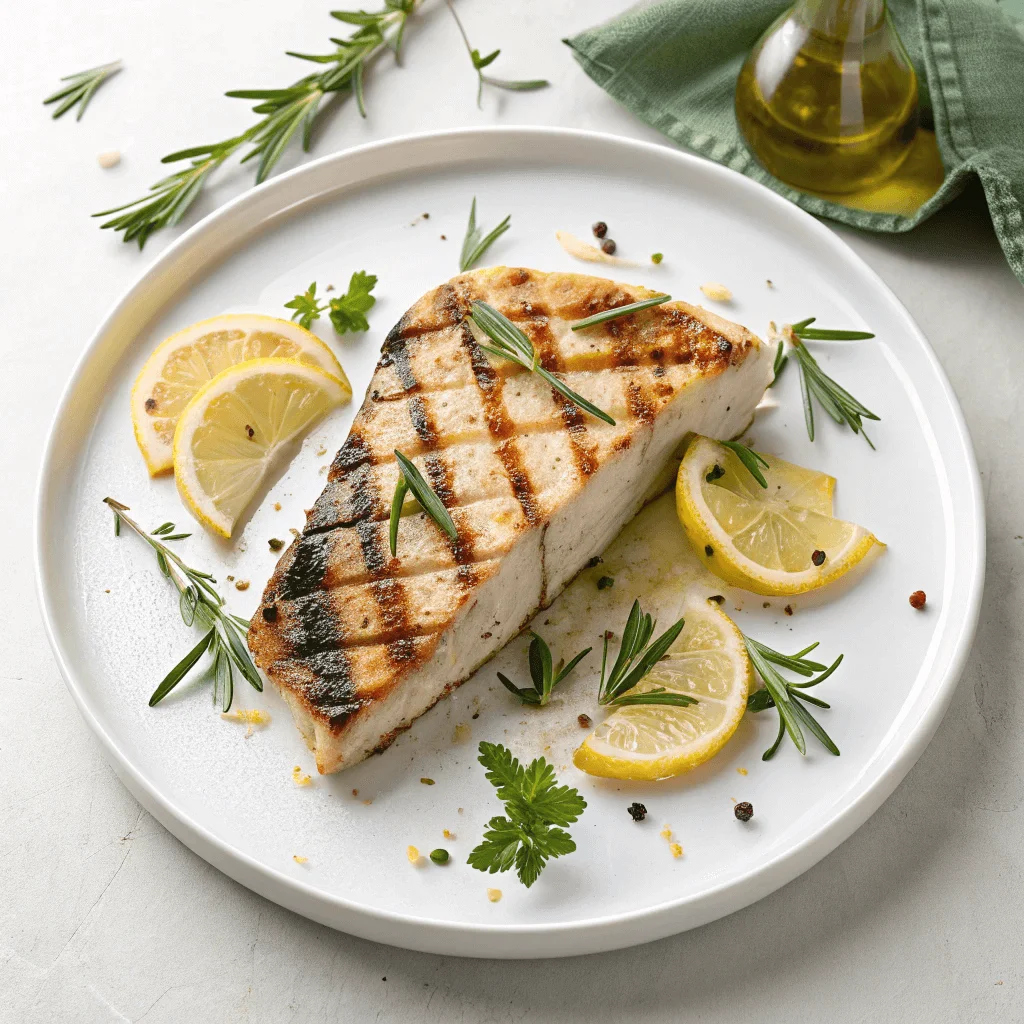
How Do You Know When Swordfish Is Fully Cooked?
Cooking swordfish to the right doneness is key to achieving a juicy, tender texture. Since swordfish is a dense, meaty fish, it should be cooked through but not overdone, as it can dry out quickly. Here are several ways to determine if your swordfish is perfectly cooked:
1. Check the Internal Temperature
- The safest and most reliable way to check doneness is by using a meat thermometer.
- Swordfish is done when it reaches 130–135°F (55–57°C) in the thickest part.
- It will continue cooking after being removed from heat, so taking it off at 130°F ensures it remains moist.
- If it reaches 140°F (60°C) or above, it may start to dry out.
🔥 Pro Tip: Insert the thermometer horizontally into the thickest part of the steak to get an accurate reading.
2. Observe the Color and Texture
- Raw swordfish is slightly translucent and glossy.
- When fully cooked, it should turn opaque and firm, but still have a little bounce when pressed.
- The edges may develop a golden crust (especially if pan-seared or grilled), but the inside should not look dried out.
🔥 Pro Tip: If the fish looks dry and flaky, it’s likely overcooked. If it’s still slightly translucent in the center, it needs another minute or two.
3. Use the Flake Test
- Gently insert a fork into the thickest part of the fillet and give it a slight twist.
- If the fish flakes easily, it’s done.
- If it resists flaking or looks raw in the center, it needs a bit more time.
🔥 Pro Tip: Unlike flaky fish like cod or tilapia, swordfish has a firmer, steak-like texture, so expect it to hold together more.
Can I Use Frozen Swordfish for This Recipe?
Yes! Frozen swordfish is a great option if fresh isn’t available. Many frozen swordfish steaks are flash-frozen at peak freshness, preserving their quality. However, to get the best results, you need to thaw it properly and handle it correctly.
How to Thaw Frozen Swordfish Properly
- Refrigerator Thawing (Best Method)
- Place the frozen swordfish in the refrigerator for 12–24 hours.
- Keep it in a sealed bag or container to prevent leaks.
- Cold Water Thawing (Faster Method)
- Place the fish (sealed in a plastic bag) in a bowl of cold water.
- Change the water every 30 minutes until thawed (usually takes 1–2 hours).
- Avoid Microwave Thawing
- The microwave can create hot spots, partially cooking the fish before you start cooking it.
- This can lead to an uneven texture.
🔥 Pro Tip: After thawing, pat the fish dry with a paper towel to remove excess moisture before marinating or cooking.
Does Frozen Swordfish Taste as Good as Fresh?
- High-quality frozen swordfish can taste just as good as fresh, especially if it’s flash-frozen soon after being caught.
- However, it’s best to avoid pre-frozen fish that has been sitting in grocery store freezers for too long, as it may develop a slightly mushy texture.
🔥 Pro Tip: If buying frozen swordfish, look for vacuum-sealed packaging and avoid any fillets with visible ice crystals or freezer burn, as this can indicate poor storage.
What Other Marinades Work Well with Swordfish?
Swordfish is versatile, and while a lemon-herb marinade is a classic choice, you can experiment with other bold and flavorful marinades to suit different cuisines. Here are some delicious alternatives:
1. Mediterranean Garlic & Herb Marinade
This option enhances swordfish with classic Mediterranean flavors.
✅ Ingredients:
- 1/4 cup extra virgin olive oil
- 2 tbsp fresh lemon juice
- 3 cloves garlic, minced
- 1 tbsp fresh oregano, chopped
- 1 tbsp fresh basil, chopped
- 1/2 tsp sea salt
- 1/2 tsp black pepper
🔥 Pairs well with: Grilled or baked swordfish, served with a Greek salad or couscous.
2. Asian Ginger-Soy Marinade
A great option for a sweet, salty, and umami-packed twist.
✅ Ingredients:
- 1/4 cup low-sodium soy sauce
- 2 tbsp honey or brown sugar
- 1 tbsp sesame oil
- 1 tbsp rice vinegar
- 1 tbsp grated ginger
- 2 cloves garlic, minced
- 1/4 tsp red pepper flakes (optional)
🔥 Pairs well with: Pan-seared swordfish with steamed rice and stir-fried vegetables.
3. Spicy Cajun Marinade
For those who love a bold and spicy kick.
✅ Ingredients:
- 1/4 cup olive oil
- 2 tbsp fresh lime juice
- 1 tsp smoked paprika
- 1 tsp Cajun seasoning
- 1/2 tsp cayenne pepper (adjust for spice level)
- 1/2 tsp garlic powder
- 1/2 tsp black pepper
🔥 Pairs well with: Grilled swordfish served with corn on the cob or blackened rice.
4. Zesty Cilantro-Lime Marinade
A fresh and citrusy marinade perfect for a tropical flair.
✅ Ingredients:
- 1/4 cup olive oil
- 2 tbsp fresh lime juice
- Zest of 1 lime
- 1 tbsp honey
- 1/4 cup chopped fresh cilantro
- 1 clove garlic, minced
- 1/2 tsp cumin
🔥 Pairs well with: Grilled or baked swordfish, served with avocado salsa or mango salad.
Final Thoughts
- Knowing when swordfish is fully cooked prevents it from drying out.
- Frozen swordfish is a great alternative if thawed properly.
- Experimenting with different marinades can transform your dish into something new every time.

